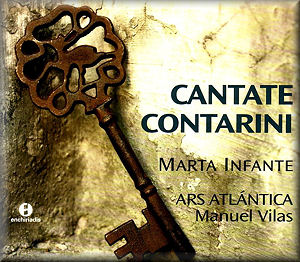| Villa Contarini, Piazzola sul Brenta |
Ars Atlántica:-
Santi Mirón (viola da gamba)
Bruno Forst (harpsichord)
Manuel Vilas (arpa doppia & direction)
recorded at the church of San Vivente, Pombeiro (Lugo), Spain, 14 - 16 July 2008.
(review by Johan van Veen in Musicweb)
Discs with music from the baroque era which comprise only anonymous compositions are rare. That is the case here, though. All cantatas on this disc are from a collection which was compiled by Marco Contarini (1632-1689). He was a member of a many-branched noble family from the Veneto, whose wealth allowed him to develop into an important patron of the arts.
Like many noblemen he owned an estate outside the city. On this estate he had two theatres built, one of which was famous throughout Europe and had a seating capacity of about 1,000. The second was smaller; it was known as the Luoco delle Vergini (the place of the maidens), because young ladies performed here at the owner's expense. That made it a kind of conservatoire, like the Ospedali in Venice. For the performances they made use of the instruments and the music Marco Contarini had collected.
The cantatas on this disc come from this collection which was bequeathed in 1839 to the main public library in Venice, the Biblioteca Marciana, where it is still preserved. The eight cantatas on the programme are all scored for a low voice and basso continuo. They probably date from around the middle of the 17th century, and stylistically they are reminiscent of the cantatas Barbara Strozzi composed in the latter part of her career. They contain recitatives and arias, but their form is less strict than the chamber cantata which was modelled by Alessandro Scarlatti in the last quarter of the 17th century.
There are very few dacapo arias, but sometimes an aria is repeated after a recitative. Recitatives and arias are not always strictly split, and some recitatives turn into a kind of arioso. It is impossible to say anything about the relationship between text and music. The booklet has the original lyrics, but only a Spanish translation. The cantatas show much variety. Si, si, son tradito is highly dramatic, and has the character of a pocket-sized opera. O voi dell'alma oppressa, on the other hand, is much more lyrical, and contains some really beautiful arias.
As much as I am annoyed at the absence of English translations of the lyrics, I have really enjoyed this disc. First of all, the cantatas are great stuff and are certainly not inferior to comparable repertoire from composers whom we do know by name. Secondly, the performances are excellent. Marta Infante is called a mezzosoprano, but she has a remarkably strong low register. Her wide tessitura allows her to explore all specifics of the various cantatas. She has a great flair for the dramatic character of some pieces, as she especially shows in the performance of Si, si, son tradito. But she also sings the more lyrical pieces very beautifully.
The support of Ars Alántica is outstanding, and in particular its strong rhythmic drive is admirable. The various combinations of viola da gamba, harp and harpsichord lend additional variety to the cantatas. In particular the use of a harp is appropriate, as it was frequently used in Italy in the 17th century. Its powerful sound, especially in its lower range, is very suitable for the more dramatic pieces. So, this disc is a most enjoyable addition to the growing catalogue of recordings with 17th-century Italian vocal music.
EAC Rip | FLAC+LOG | 331 MB | Full booklet scans | Total Playing Time: 61:45
Filesonic
Download
Fileserve
Download
Villa Contarini: Photo Gallery - Exterior
Villa Contarini: Photo Gallery - Interior
History of the Villa Contarini




No comments:
Post a Comment